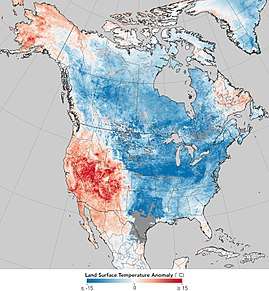2017–18 North American cold wave
The 2017–18 North American cold wave was an extreme weather event in North America in which record low temperatures gripped much of the Central, Eastern United States, and parts of Central and Eastern Canada. Starting in late December as a result of the southward shift of the polar vortex, extremely cold conditions froze the eastern United States in the last few days of 2017 as well as into the new year. Following a brief respite in mid-January, cold temperatures swung back into the eastern U.S. shortly afterwards. The cold wave finally dissolved by around January 19, as near-average temperatures returned.
Part of the 2017–18 North American winter | |
 Temperature anomaly map of North America during the week of December 26, 2017 to January 2, 2018, showcasing the below-average temperatures. | |
| Formed | December 23, 2017 |
|---|---|
| Dissipated | January 18, 2018 |
| Damage | Unknown |
| Areas affected | Canada East Coast of the United States Midwestern United States |
Several winter weather events accompanied the cold wave, the most significant one was a powerful blizzard that impacted the Northeastern U.S. in the first few days of 2018. Some of these events impacted areas that normally do not receive snow, such as Louisiana and Texas. In an extremely rare event, Tallahassee, Florida in extreme north Florida received trace amounts of frozen precipitation for the first time in more than 30 years. In addition, many places broke records for coldest temperatures in the final week of 2017 and the first part of 2018.
History
Like most normal cold waves, the cold wave was caused by the southwards movement of the polar vortex into the United States due to changes in the jet stream in late December 2017. Because of an "omega" block pattern that set up around Christmas time – a shift to a pattern with a ridge settling over the western continental U.S and a trough in the central- to eastern parts of the U.S, below-average temperatures occurred through much of the Lower 48 for the final week of 2017 – leading to many records being broken.[1] The pattern continued into the first week of 2018, with more record lows being set following a significant blizzard that impacted the Northeastern United States in early January. By January 11, warmer temperatures had surged northeastwards, although following a winter storm a few days later, cold temperatures returned to the Northeast.
The cold wave had an impact on New Year's Eve celebrations in the affected regions; some Canadian cities chose to scale back their ancillary outdoor festivities (but still scheduling celebrations at midnight), including Calgary (which forecast a high of −26 °C (−15 °F)), Ottawa (overnight low of −24 °C (−11 °F)), and Toronto (−15 °C (5 °F), −30 °C (−22 °F) after wind chill), although the CBC reported that Montreal and Winnipeg decided to go on without any changes.[2][3] New Year's Eve celebrations at New York City's Times Square were the second-coldest on record, at 9 °F (−13 °C) (−4 °F (−20 °C) after wind chill).[4][5]
Record temperatures
In 2017, Watertown, New York and Buffalo, New York, had their coldest final week on record for the year. The National Weather Service indicated that a temperature of −15 °F (−26 °C) took place in Omaha, Nebraska on December 30, 2017, lower than the previous record set in 1884.[6]
On January 1, 2018 in Aberdeen, South Dakota, a new low temperature of −32 °F (−36 °C) was set.[7] In Indianapolis, Indiana, the temperature reached a new low of −12 °F (−24 °C).[8] On January 2, a daily record low in Sioux City, Iowa was set at −28 °F (−33 °C). Other daily record low temperatures included Cedar Rapids, Iowa −23 °F (−31 °C), Pierre, South Dakota −21 °F (−29 °C), South Bend, Indiana −15 °F (−26 °C), Quincy, Illinois −12 °F (−24 °C) and Lynchburg, Virginia 3 °F (−16 °C).[9] On January 5, Toronto broke a 59-year-old record with a morning low temperature of –23 °C (–9 °F) at the Pearson International Airport weather station.[10]
On January 6, Raleigh–Durham International Airport in North Carolina set a record for the longest time spent below 32 °F (0 °C), 159 hours according to WTVD. The record of eight days set in 1895 and 1917 still had yet to be broken, but temperatures were not recorded every hour at that time.[11] On January 7, temperatures in Massachusetts were so cold that part of Buzzards Bay froze.[12]
See also
References
- Heim. "Synoptic Discussion – December 2017 – State of the Climate – National Centers for Environmental Information (NCEI)". noaa.gov. Retrieved January 17, 2018.
- "Some NYE events on Parliament Hill cancelled due to cold". CBC News. Retrieved January 4, 2018.
- "Calgary, Toronto among Canadian cities rolling back NYE events due to extreme cold". CBC News. Retrieved January 4, 2018.
- "Times Square braces for one of coldest New Year's Eve parties on record". The Guardian. Associated Press. December 31, 2017. ISSN 0261-3077. Retrieved January 1, 2018.
- Theresa Waldrop; Catherine E. Shoichet. "New year brings record cold across US". CNN.com. Retrieved January 2, 2018.
- "Dangerously Cold Temperatures Grip Midwest as 2018 Begins". Time.com. Archived from the original on January 1, 2018. Retrieved January 2, 2018.
- "Let it snow — maybe even in Florida as cold wave tightens grip on USA". Usatoday.com. Retrieved January 4, 2018.
- "Record-breaking cold sweeps US in first days of 2018". January 2, 2018. Retrieved January 4, 2018 – via The Christian Science Monitor.
- "Dangerously Cold Temperatures to Grip Northeast Following Winter Storm Grayson as Arctic Outbreak Continues". Weather.com. Retrieved January 4, 2018.
- "Toronto snaps 59-year-old record as extreme cold continues". cp24.com. Retrieved January 7, 2018.
- Johnson, Joe (January 6, 2018). "How cold is it? Triangle is approaching record territory". News and Observer. Retrieved January 7, 2018.
- "Spectacular Freeze in Massachusetts" (Video). weather.com. The Weather Channel. January 8, 2018. Retrieved January 8, 2018.